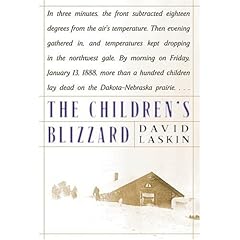“Januray 12, 1888, began as an unseasonably warm morning aacross Nebraska, the Dakotas, and Minnesota, the weather so mild that children walked to school without coats and gloves. But that afternoon, without warning, the atmosphere suddenly, violently changed. One moment the air was calm; the next the sky exploded in a raging chaos of horizontal snow and hurricane-force winds. Temperatures plunged as an unprecedented cold front ripped through the center of the continent.
By Friday morning, January 13, some five hundred people lay dead on the drifted prairie, many of them children who had perished on their way home from country schools.”

The Children’s Blizzard was both fascinating and disturbing. I’ve never lived “up North.” Reading Little House on the Prairie books is the extent of my exposure to blizzards and the like. So reading about the horrible possibilities inherent in an American plains blizzard was eye-opening. Did you know:
that in a particularly bad snowstorm something can occur called St. Elmo’s fire or point discharge, manifested as sparks of static electricity rippling through the air that discharge into the nearest conductor? Human bodies make great conductors.
that what “windchill factor” really means is that the actual temperature, say 25 degrees, is not indicative of how fast you’ll freeze to death? “If the wind is blowing at 30 miles an hour, the exposed parts of your body are losing heat at the same rate that they would if the temperature were in fact 8 degrees.”
that some people just before they freeze to death throw off all their clothes and remove any wraps from their necks? It’s called “paradoxical undressing”.
that sometimes people who survive for hours in below freezing temperatures, die of a heaert attack when they are moved? The heart has gone into a kind of suspended animation and can’t stand the shock of movement and renewed circulation.
There’s lots more: chapters about weather and what causes a blizzard like that of January 12, 1888, chapters that explain the abilities and the limitations of weather forecasters in the late 1800’s, and stories. Laskin follows the stories of five families who suffered, some more and some less, in the terrible blizzard of 1888. Most of those he tells about were immigrant families recently moved here from Germany or Ukraine or Scandinavia. He also explains why these immigrant families, although they were used to cold and freezing temperatures, were completely unprepared for an American prairie blizzard.
One interesting contrast that Laskin touches on came to my mind early in my reading. How do you think people in 1888 reacted to a disaster of this magnitude?
“Today a “surprise” storm that killed over two hundred people would instigate a fierce outcry in the press, vigorous official handwringing, and a flood of reports by every government agency remotely involved, starting with the National Weather Service.”
Oh, yes, and this little observation was written pre-Katrina. I could add that the politicians would be clamoring to offer compensation to any who had suffered in the storm, and the Democrats would imply that the entire storm and its death toll were somehow George Bush’s fault. The newspapers would be investigating what went wrong, and sinister conspiracy theories would run rampant over the internet.
In 1888, however, people called the blizzard “an act of God,” not in the sense of blaming God, but in a sense of acceptance that bad things happen and that the weather is no respecter of persons. The journalists found heros and heroines to write about, people who survived or rescued others, and the newspapers collected funds to distribute to some of the survivors of the storm and to the families of those who died. Only one person left the Army Signal Corps (the government agency responsible at that time for forecasting the weather) in the storm’s aftermath, and that one man simply resigned and went back to his regular army job. For better or for worse, my, how times have changed.
All my friends up North should find this book to be riveting. I think this book would be excellent as the basis for a homeschool unit study combining history, geography, human physiology, and meteorology for those children who are old enough to handle the somewhat gory details. The lesson, of course: don’t be caught out on the prairie in a blizzard. I don’t expect to get caught in any snowstorms myself, but still as a piece of American history, I was engrossed by the story of the storm that became known as “The Schoolchildren’s Blizzard.”
Aloha! This post is in the 5th Carnival of Homeschooling here>/a>.
oops. Messed up the html. The carnival is here.
This was a very tradagic thing, This helped me know what it was like back then for a paper. I live in Arnold, so it was really fasinating to me. Thanks it helped a lot.